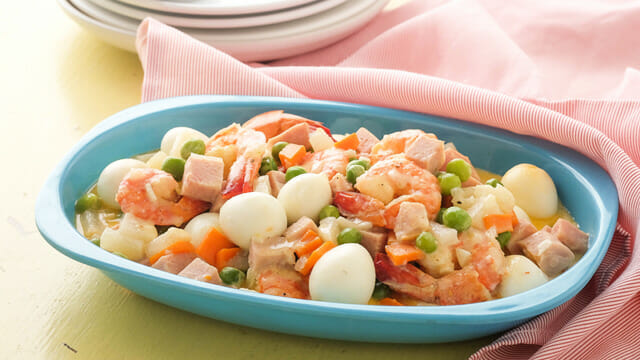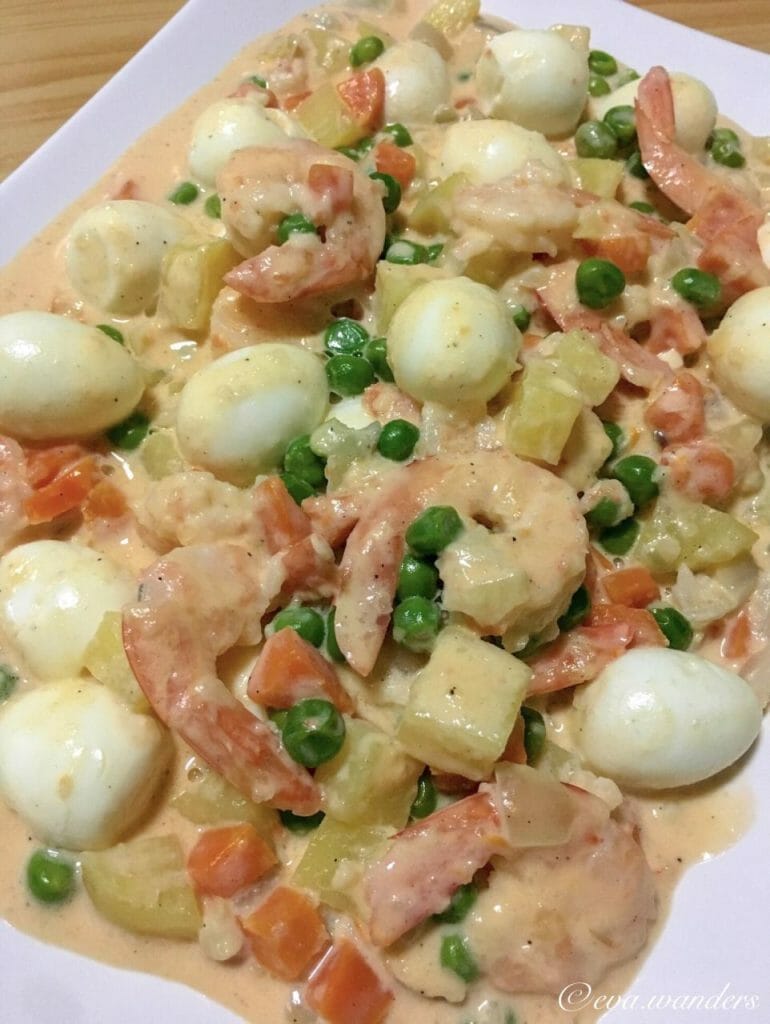Hey everyone! How is everybody doing today? I am quite excited to share with you this simple Filipino recipe for Sipo Eggs. Are you ready?
You are probably raising an eyebrow and wondering what the heck is Sipo Eggs. But despite its weird sounding name, Sipo Eggs is a creamy and delicious concoction of quail eggs, shrimps, peas, and vegetables that originated from the Pampanga region of the Philippines. Pampanga is the Philippines’ answer to Japan’s Osaka; in other words, it is the culinary capital of the Philippines.

Because Sipo Eggs is served on special occasions like graduation and birthday parties, it is easy to imagine spending many hours being tied to the stove. However, the opposite is actually true. Forget fussing in the kitchen, any college student would be able to come up with this dish in the time that it takes to boil instant ramen. Just kidding.? Maybe not, but I’ll place this just a notch higher than ramen or fried eggs on the difficulty meter.
I was originally planning to submit this as my entry for the #EasyPeasy challenge that I joined last month, but I couldn’t find singkamas (that’s jicama or Mexican turnip) in my local grocery. I discovered they stocked up on some last week, so I went ahead and bought some. There was nothing to stop me from cooking Sipo Eggs anymore!
Like I said, it’s just a tad higher than fried eggs on the difficulty meter, but even less stressful because unlike eggs, there’s no need to worry about scorchingly hot oil spitting on you.
The bulk of the effort goes towards prepping the ingredients. You need to cut and dice the carrots and jicamas and boil the quail eggs. If it is your first time to boil quail eggs, please take care not to overboil them. They should be done in less than 5 minutes.
If you’re using frozen peas like I did, remember to thaw them for a few minutes by soaking them in a bowl of water before cooking. Enjoy cooking!

creamy sipo eggs
Ingredients
- 30 grams butter
- 1 medium sized onion sliced
- 2 cloves garlic minced
- 250 grams shrimp shelled and deveined
- 1 medium sized carrot diced
- 1 medium sized jicama singkamas, diced
- 1 dozen quail eggs boiled and shelled
- 1 cup frozen green peas thawed
- 120 ml 1/2 cup water
- 240 ml 1 cup heavy cream
- salt and pepper to taste
Instructions
- Melt the butter in a pan. Add the onions and garlic and saute them until onions are soft.
- Add the shrimps and cook until pinkish. Add the carrots and the jicama (singkamas) and cook for a minute.
- Add the water and the cream. Let it simmer until the carrots and jicama (singkamas) are tender.
- Add the quail eggs and peas. Season with salt and pepper and cook for a few minutes until the sauce is thick and creamy.
Video
Notes
Creamy Sipo Eggs

When it comes to fried egg dishes, there are many options for making a creamy sipo egg. It is traditionally served during special occasions, but you can also enjoy sipo eggs at home! This delicious dish pairs well with steamed rice and is easy to make. It keeps well and can be stored in a tightly-fitting lid for several days. Simply reheat the sipo eggs until the internal temperature reaches 165 degrees Fahrenheit, add more water and fish sauce, and serve with steamed rice.
Recipe
Traditional Kapampangan fare, sipo egg is made from quail eggs, green peas, shrimps, and chicken cutlets or gizzards. Served with steamed rice, sipo is easy to prepare. Once the cooked egg has reached an internal temperature of 165 degrees Fahrenheit, it can be stored in a tightly-fitting container. If the recipe has run out of eggs, simply reheat the dish with more water and fish sauce.
To prepare this dish, start by heating up two to three cups of chicken stock in a medium saucepan. Add quail eggs and green peas and cook for about three minutes. Then add the garlic and carrots. Cook until the vegetables are soft. After three minutes, add the sliced corn and cashews. Add the remaining ingredients, and bring to a simmer. Season with salt to taste.
Origin

If you’re looking for a dish to enjoy at special occasions, try the Filipino classic, Sipo Egg. This delicious dish is served in the northwest region of the Philippines in the province of Pampanga. Its unique recipe is a mixture of vegetables, quail eggs, shrimps, chicken cutlets and gizzards. It was originally introduced to Kapampangans during the 1950s. Though it does not include cream, it is made from water and potato starch.
The Philippine version of this dish has roots in Chinese cuisine. This dish has many components and is a popular side dish in Pampanga. Sipo Egg contains quail eggs, shrimp, vegetables, ham, cashews, and garlic. It is then smothered in a creamy white sauce. The flavor is truly divine. It is best served hot, and can be eaten warm or cold.
Preparation

Preparation of creamy sipo eggs requires some simple steps. The sipo egg is traditionally served with steamed rice. You can also store it in an airtight container for up to 3 days. If you decide to serve it again, you can reheat it by adding more water and seasoned with a little fish sauce. Once you are ready to eat, serve it with steamed rice.
Sipo Egg is a popular Filipino dish originating in Pampanga. It is usually made with quail eggs, shrimps, vegetables, and chicken gizzards. The quail eggs and vegetables are cooked in a creamy sauce until the eggs are tender. Then, you add all-purpose cream, cashew nuts, and a bit of salt. After simmering for about two minutes, serve the dish with rice or noodles.
Store-bought version

If you are looking for a simple and easy-to-prepare breakfast item, try making your own creamy sipo eggs. This traditional Filipino dish is topped with a creamy sauce, quail eggs, and mixed vegetables. Served during special occasions, this dish is sure to impress your family and guests. To make this delicious breakfast staple, simply follow the steps below. Once the mixture is smooth and creamy, simply serve it with steamed rice. It keeps well in the refrigerator for two to three days, and can be reheated by adding a bit of water or cream to the dish before serving.
If you want to prepare your own Sipo Eggs, there are many shortcuts that you can use. These include a mix of vegetables, quail eggs, shrimp, and ham. You can also add minced meat to make your meal even more festive. You can also purchase store-bought sipo eggs that come in a creamy sauce. You can even make this dish on your own and save time and money by making it ahead of time.
Price
Creamy sipo eggs are a popular Filipino dish, traditionally served on special occasions. The dish is easy to make and pairs well with steamed rice. Sipo eggs are best served at room temperature, but they can be reheated to 165 degrees. If you don’t have time to prepare a sipo egg right away, you can store them in a tightly sealed container. To reheat, simply add water or fish sauce and heat to 165 degrees. Serve sipo eggs with steamed rice.
The main ingredients for sipo eggs are shrimp, quail eggs, vegetables, and cashews. Then, the dish is smothered with a creamy sauce. You can also add shrimp and ham to the dish. It is delicious served on its own or with steamed rice. Make sure you use high-quality ingredients and cook the dish to order, or it won’t be as delicious as you think.


